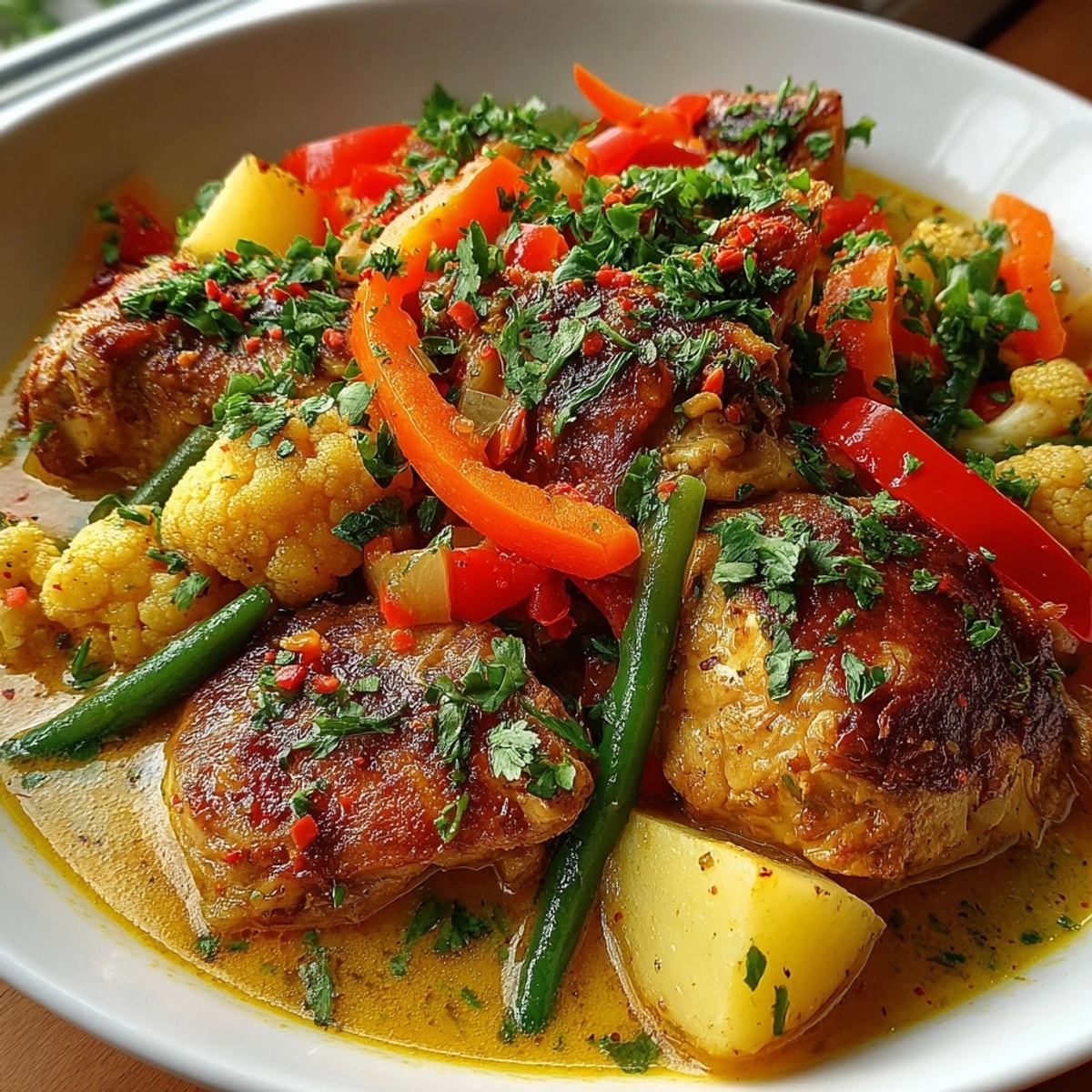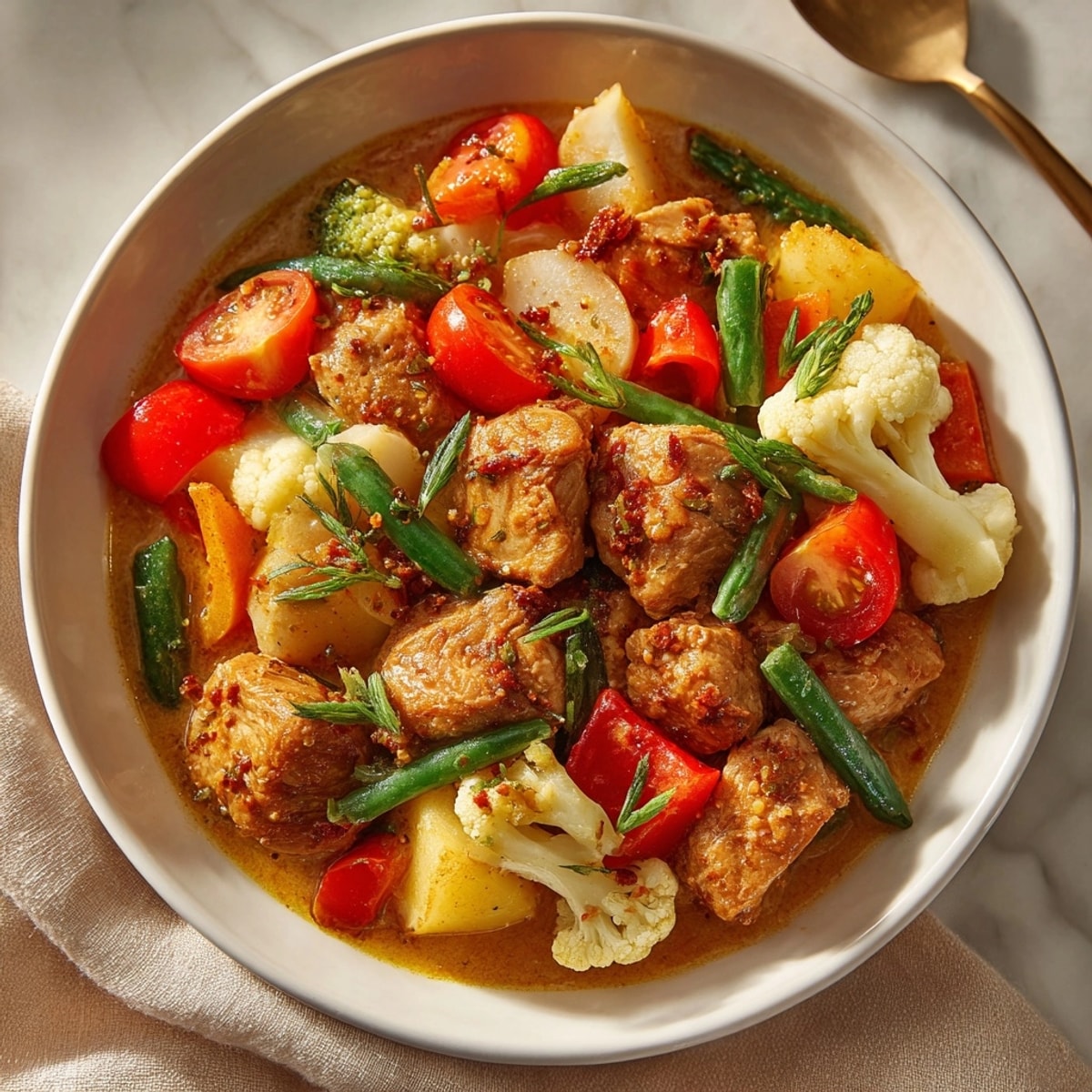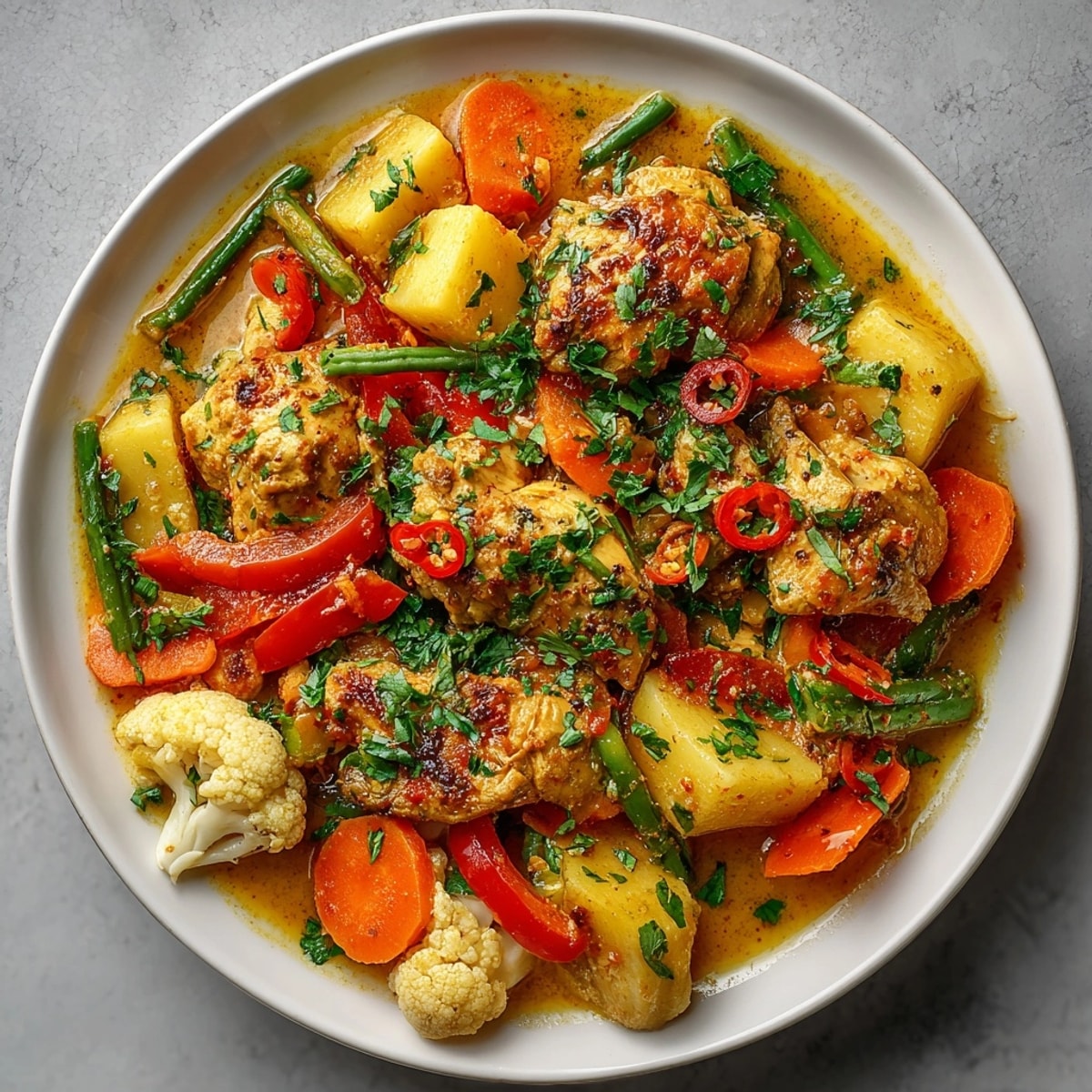 Save
Save This fragrant chicken and vegetable curry has been my family's go-to comfort meal for years, combining tender chicken thighs with colorful vegetables in a rich coconut sauce that's perfectly spiced without overwhelming heat.
I first created this curry when trying to please both my spice loving husband and my heat sensitive children. The result was this perfectly balanced dish that has since become our Sunday dinner tradition, with everyone eagerly gathering around the table.
Ingredients
- Boneless skinless chicken thighs cut into bite sized pieces: Thighs remain juicier than breast meat and add richness to the curry.
- Onion garlic and ginger: This aromatic trinity forms the flavor foundation for any good curry. Always use fresh ginger for the brightest taste.
- Carrots red bell pepper green beans cauliflower and potato: This colorful vegetable medley provides different textures and nutrients. Choose firm vegetables for best results.
- Fresh tomatoes: They break down during cooking to add natural sweetness and acidity. Roma or vine ripened varieties work best.
- Curry powder turmeric cumin and chili powder: This spice blend creates depth without requiring dozens of individual spices. Look for curry powder that smells fragrant and hasn't been sitting in your pantry for years.
- Coconut milk: Provides creaminess and balances the spices. Full fat coconut milk creates the most luxurious texture.
- Chicken stock: Adds savory depth while thinning the sauce to the perfect consistency. Homemade is best but quality store bought works well too.
- Fresh cilantro: Adds a bright finishing touch that lifts the whole dish. If you dislike cilantro, substitute with fresh basil.
Instructions
- Sauté The Aromatics:
- Heat vegetable oil in a large Dutch oven over medium heat until shimmering but not smoking. Add finely chopped onion and cook for a full 3 to 4 minutes, stirring occasionally until they become translucent and slightly golden at the edges. This initial cooking builds the first layer of flavor for your curry. Add minced garlic and grated ginger, cooking for exactly one minute until their aroma fills your kitchen but before they begin to brown and become bitter.
- Brown The Chicken:
- Add the chicken thigh pieces to the pot, spreading them in a single layer if possible. Allow them to cook undisturbed for 2 minutes before stirring to develop some color. Continue cooking another 2 to 3 minutes until the chicken pieces have light golden spots but don't need to be fully cooked through yet. The chicken will finish cooking in the sauce.
- Bloom The Spices:
- Sprinkle all the spices directly over the chicken mixture curry powder, turmeric, cumin, chili powder, salt, and freshly ground black pepper. Stir continuously for about 30 seconds until the spices coat everything and become aromatic. This quick toasting in oil awakens the flavor compounds in the spices before adding liquid.
- Add Vegetables And Liquids:
- Add all the prepared vegetables carrots, potato, bell pepper, green beans, cauliflower, and tomatoes to the pot. Stir well to coat everything with the spiced oil. Pour in the coconut milk and chicken stock, using a wooden spoon to scrape up any browned bits from the bottom of the pot these contain concentrated flavor. Stir until everything is well combined.
- Simmer To Perfection:
- Bring the mixture to a gentle boil, then immediately reduce heat to low. Cover the pot with a tight fitting lid and allow to simmer for 25 to 30 minutes, stirring gently every 5 to 7 minutes to prevent sticking. The curry is done when the chicken is tender and no longer pink inside, and the vegetables can be easily pierced with a fork. The potatoes usually take the longest, so test those for doneness.
- Final Adjustments And Serving:
- Taste the curry and adjust seasoning with additional salt or spices if needed. The flavors should be well balanced with no single note dominating. If the sauce is too thin, simmer uncovered for a few additional minutes. If too thick, add a splash of stock or water. Serve hot in bowls garnished generously with fresh chopped cilantro.
 Save
Save The curry powder is truly the heart of this recipe. While it might seem like a shortcut ingredient, a quality curry powder contains up to 20 different ground spices perfectly balanced. I keep several varieties in my pantry ranging from mild to hot, allowing me to adjust based on who will be joining us for dinner.
Storage and Leftovers
This curry actually improves with time as the flavors meld together in the refrigerator. Store leftovers in an airtight container for up to 3 days. The curry will thicken considerably when chilled, so when reheating, add a splash of water or coconut milk to restore the original consistency. Warm gently over medium low heat, stirring occasionally to prevent scorching.
For freezing, cool the curry completely before transferring to freezer safe containers. Leave about an inch of headspace to allow for expansion. The curry will maintain its quality for up to 3 months frozen. Thaw overnight in the refrigerator before reheating. The vegetables may soften slightly after freezing and reheating, but the flavor remains excellent.
Vegetable Substitutions
This curry welcomes almost any vegetable you have on hand, making it perfect for using up produce before it spoils. Hard root vegetables like sweet potatoes, parsnips, or turnips can replace regular potatoes. Broccoli works beautifully instead of cauliflower. Frozen peas or corn can be added in the last 5 minutes of cooking for extra color and sweetness.
For a spring version, try asparagus, peas, and new potatoes. In summer, zucchini, yellow squash, and eggplant create a lighter variation. Fall calls for butternut squash, mushrooms, and kale. The only rule is to add quicker cooking vegetables later in the process to prevent them from becoming mushy.
Serving Suggestions
While perfectly delicious on its own, this curry truly shines when paired with sides that complement its flavors and textures. Steamed basmati rice is the classic accompaniment, its fragrant grains ideal for soaking up the curry sauce. For a healthier option, try brown rice or cauliflower rice.
Warm naan bread or chapati makes an excellent addition, perfect for scooping up every last bit of sauce. For a complete Indian inspired feast, serve alongside cooling cucumber raita, mango chutney, or a simple kachumber salad of diced cucumber, tomato, and onion with lemon juice.
Making It Ahead
This curry is an excellent candidate for make ahead meals. You can prepare it up to two days in advance and refrigerate. The flavors will actually intensify and meld together beautifully during this time. When ready to serve, gently reheat on the stovetop, adding a small amount of water or stock if needed to thin the sauce.
For meal prep, portion the cooled curry into individual containers along with cooked rice or your preferred side. This creates grab and go lunches or dinners that can be quickly reheated in the microwave. A fresh sprinkle of cilantro after reheating will brighten the dish and make it taste freshly made.
 Save
Save Serve hot in bowls garnished generously with fresh chopped cilantro for a vibrant finish that cuts through the richness of the curry.
Recipe FAQ Section
- → How do I ensure the chicken stays tender?
Simmer gently over low heat and avoid overcooking once the chicken is just cooked through for maximum tenderness.
- → Can I make this dish ahead of time?
Yes, flavors deepen after a day in the fridge. Gently reheat on the stove, adding a splash of stock if needed.
- → Are there vegetarian alternatives?
Swap chicken for chickpeas or firm tofu to create a flavorful vegetarian version without losing texture or taste.
- → Which sides pair well with this dish?
Steamed basmati rice and naan work beautifully to soak up the fragrant coconut sauce. Try with a light salad for freshness.
- → How spicy is this curry?
The dish is mildly spiced, but you can adjust chili powder or add fresh chili to suit your heat preference.
- → What garnishes work best?
Fresh chopped cilantro is recommended for brightness, or add sliced red chili and a squeeze of lime for extra zing.